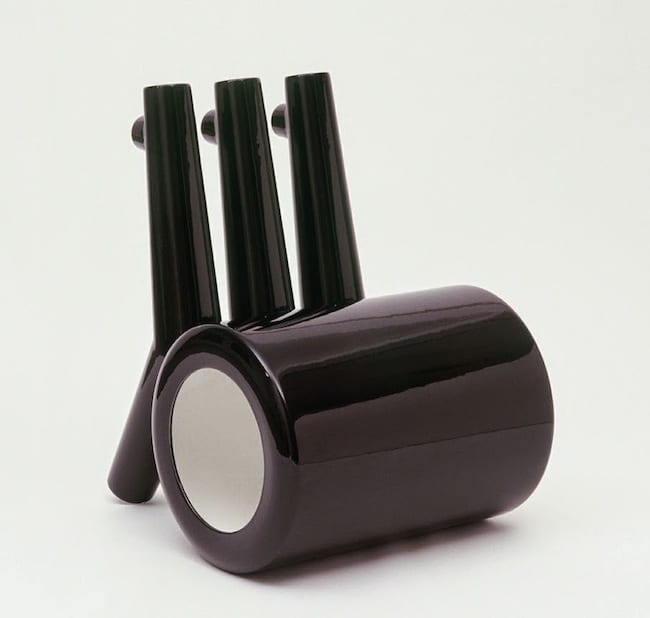The Design Miami/Basel fair (Jun 17 – 24, 2014), held in the stunning building by Herzog and de Meuron, is a very different event from Art Basel. The sense of frenzy is missing, the level of connoisseurship is demonstrably higher and there is no chance of Ordinary Plate with Two Rubber Bands by Waltercio Caldas getting any respect in this venue. The buyers here- whether they be decorators, collectors or curators- know their stuff and on average the ratio of A-class material is higher here than at Art Basel. It is smaller; just over 50 galleries compared to 286 and 26,000 visitors compared to 70,000. It is still very much a boutique.
The fair functions as a halfway house between pure design and design-art hybrids with more of an emphasis on the latter. Some artists with this fair deserve to be on Art Basel such as Ron Nagle. A few are on both; the Haas Brothers and Takuro Kuwata. It also tilts backwards into the 20th century so if it’s contemporary design you are seeking, you should go to Milan for Design Week.
An exception was the stunning new dinner service by Bob Waardenberg for De Intuitiefabriek shown by Priveekollektie, Heusden aan de Maas Netherlands. The decoration was drawn with ceramic pencil and was dynamic en masse in its custom-designed crockery glass and wood hutch. At the opposite extreme, and the “it” object this year (the most publicized), was a 2001 ceramic chair of dubious utility by Satyendra Pakhalé, “Roll Ceramic Chair” (2001-08) from Ammann Gallery, Cologne.
The gallery states that the designer was something of a futurist having already designed a walking stick for strolling on the moon. This did not encourage me to believe that the chair was anything but pure sculpture. In that context, while a bit clumsy, it is perfectly crafted and exerts improbable charm as much as I try to resist it.
For the rest, Brussels’ Pierre Marie Giraud’s booth was up to its usual high standard with a brace of excellent Nagle sculptures. To quote Dave Hickey, the works looked like something Faberge would have made if the Russian jeweler to the Czar had surfed and taken acid. Hickey’s quote could as easily have applied to Takuro Kuwata’s radiant gold bowl as well.
Jason Jacques Inc. chose to go all 20th century this time (he usually juxtaposes extreme glazing from early 20th century and the present, creating an intriguing time warp) and three works were of particular interest: a pair of lidded jars by T.A.C Colenbrander, another pair by Taxile Doat. and the superb Sprouting Vase, possibly unique by Axel Salto. All are exceptional artists, and except for Salto, underrated by the market. Colenbrander’s painterly vision, if taken in isolation, puts him in the radical company of Vincent van Gogh and others. And while America’s adored Adelaide Alsop Robineau is rightly revered, Taxile Doat, her mentor, is far better.
For Design Miami/Basel’s design at large program (an exhibition platform that presents monumental pieces that surpass the scope of the gallery booth) Demisch Danant presented the work of American artist Sheila Hicks, who created Séance, an architectural installation which hangs the walls of the gallery expanse with huge, colorful tufts of fabric.
The corporate presentation this year was industrial designer Konstantin Grcic, who used seven tailgate doors from Audi TT sports cars to create a mobile pavilion with seven futuristic entrances for this year’s fair, pointing out that a car is, “mobile architecture.”
While the fair’s dependable quality is an asset, it is also its liability. It needs to be shaken up a little without losing its current base. The number of exhibitors should be increased, the product more varied and more focus should be placed on the contemporary edge in the real market rather than fantasy works such as Grcic’s pavilion. It cannot take on Design Week in Milan head-to-head but it can become more dynamic. That might well be what the new executive director, Rodman Primack, a polymath with a broad resume as a designer and auction marketer, has in mind.
Garth Clark is the Chief Editor of CFile.
Above image: Satyendra Pakhalé, Roll Ceramic Chair, 2001-08, ceramic and carbon fiber, 31 inches height. Edition of 7 plus 3 AP. Ammann Gallery, Cologne.
Any thoughts about this post? Share yours in the comment box below.





De-Intuitiefabriek and Bob Waardenburg Composition, 2014, with dedicated cabinet. Priveekollektie, Heusden aan de Maas Netherlands.


Arik Levy, Totem, 2013, ceramic. Priveekollektie, Heusden aan de Maas Netherlands


Banraby Barford, Fox 1, 2014, wire, 36 inches. David Gill London.
Barnaby Barford Avarice, 2013, ceramic and mirror, (from the Seven Deadly Sins series), 88 inches. David Gill London.

Betty Woodman, Wallpaper 2, 2013. Salon 94, New York.

Kristin McKirdy, Untitled, 2014, ceramic, 9 inches. Pierre Marie Giraud, Brussels.

Takuro Kuwata, Gold bowl, 2014. Pierre Marie Giraud, Brussels.

Ron Nagle, Balky Caucus, 2014, mixed media, 4.8 inches. Pierre Marie Giraud, Brussels.

Ron Nagle, Indecent Docent, 2014, ceramic. Pierre Marie Giraud, Brussels.


T.A.C. Colenbrander, Earthly Delights Pair, 1921, glazed earthenware, 21 inches height. Jason Jacques, New York.

Taxile Doat, Pate sur pate Gourds, 1903, porcelain, 24 inches height. Jason Jacques Inc., New York.

Axel Salto, Sprouting Vase, ca. 1940, stoneware, 17 inches height. Jason Jacques Inc., New York.

Wilhelm Kage, collection of vases from the Farsta Series, ca. 1955, stoneware, tallest 12 inches

Peter Orlando,69 Vases, 1960, glazed ceramic, 11 inches height. Thomas-Fritsch-ARTRIUM, Paris.



Sheila Hicks, Séance, 2014, fabric


Konstantin Grcic, Pavilion, 2014, mixed media

The Entrance to Design Miami/Basel.

Add your valued opinion to this post.